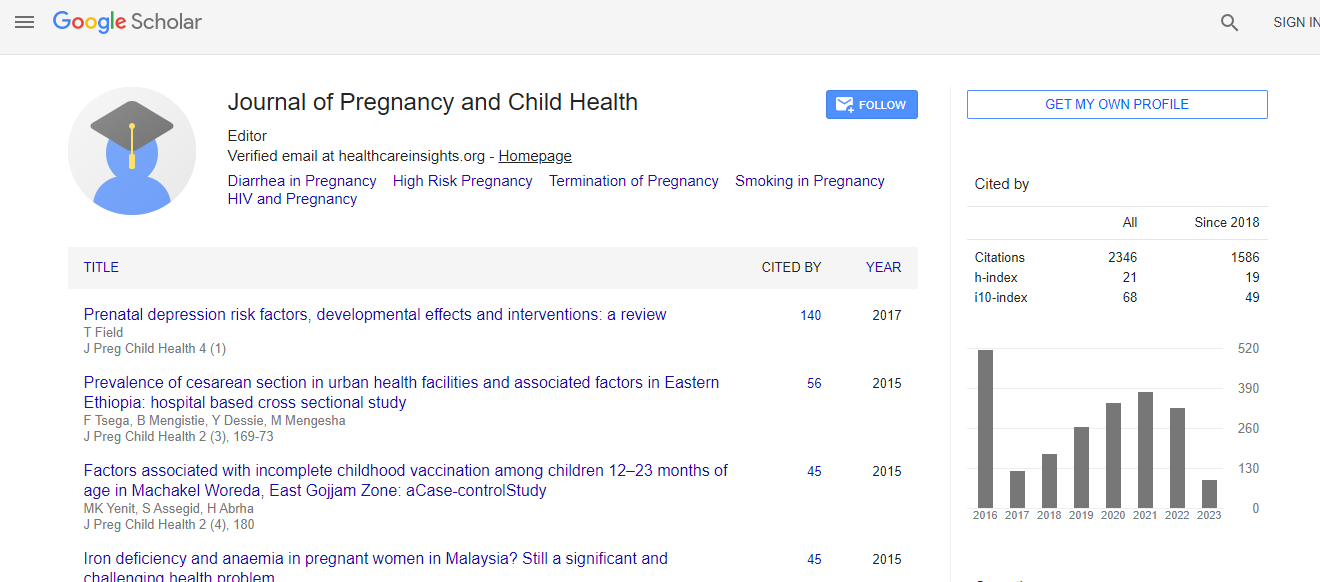Our Group organises 3000+ Global Conferenceseries Events every year across USA, Europe & Asia with support from 1000 more scientific Societies and Publishes 700+ Open Access Journals which contains over 50000 eminent personalities, reputed scientists as editorial board members.
Open Access Journals gaining more Readers and Citations
700 Journals and 15,000,000 Readers Each Journal is getting 25,000+ Readers
Google Scholar citation report
Citations : 3013
Journal of Pregnancy and Child Health received 3013 citations as per Google Scholar report
Journal of Pregnancy and Child Health peer review process verified at publons
Indexed In
- Index Copernicus
- Google Scholar
- Academic Keys
- RefSeek
- Hamdard University
- EBSCO A-Z
- OCLC- WorldCat
- Publons
- Geneva Foundation for Medical Education and Research
- Euro Pub
- ICMJE
Useful Links
Recommended Journals
Related Subjects
Share This Page
Controversies in the diagnosis and management of polycystic ovary syndrome in adolescents
7th World Congress on Polycystic Ovarian Syndrome & Infertility
ELENE ASANIDZE
University Geomedy, Georgia
ScientificTracks Abstracts: J Preg Child Health
Abstract
Statement of the Problem: Currently, for the diagnosis of PCOS the criteria adopted by the Rotterdam Consensus in 2003 are also used in adolescents. However, these criteria do not take into account the peculiarities of adolescent physiology. There was recognition of the risk of over and incorrect diagnosis in adolescents if ultrasound criteria were included in this age group, which can also influence an adolescents├ó┬?┬? quality of life . The purpose of this study was to elaborate the identification criteria for a ├ó┬?┬?risk group├ó┬?┬? for developing PCOS, and diagnostic criteria for PCOS in adolescents. Methodology: the study involved 154 adolescents. Group I-adolescents with PCOS (n60), Group II-with an ├ó┬?┬?increased risk├ó┬?┬? of PCOS (n48), and Group III-control group (n46)├ó┬?┬? adolescents without personal and family history of PCOS. PCOS patients met all 3 diagnostic criteria of the Rotterdam consensus, Group II was accepted as ├ó┬?┬?menstrual irregularities and clinical and/or biochemical hyperandrogenism├ó┬?┬? Results: In Group I and Group II AMH and SHBG did not differ significantly. In Group I and Group II, the average AMH level was significantly higher, while SHBG was significantly lower than in the controls In Group I, index of insulin resistance and the number of antral follicles (AFC) were significantly higher than in the comparison groups There was no significant difference in ovarian volume between comparison groups. In Group I and ├ó┬?┬?Group II had different types of menstrual which was significantly higher than in the controls. Conclusion: A combination of AMH, SHBG, clinical and biochemical hyperandrogenism and menstrual irregularities may be considered as diagnostic markers of PCOS in adolescents and for the identification of a ├ó┬?┬?risk group├ó┬?┬? for developing PCOS. Ultrasound estimation of AFC are a more specific marker of ovarian morphology in adolescents with PCOS, rather than ovary volume Recent Publications (of Asanidze Elene) 1.Rotterdam ESHRE/ASRM-sponsored PCOS consensus workshopgroup Revised 2003 consensus on diagnostic criteria and longterm health risks related to polycystic ovary syndrome (PCOS). Hum Reprod. 2004 2.Ramezani F, Amiri M. Polycystic ovary syndrome in adolescents: challenges in diagnosis and treatment. Int J Endocrinol Metab. 2019 3.Asanidze E, Kristesashvili J, Parunashvili N, Karelishvili N, Etsadashvili N. Challenges in diagnosis of polycystic ovary syndrome in adolescence. Gynecol Endocrinol. 2021Biography
Being the obstetrician-gynecologist, children gynecologist of the Center for Gynecological Endocrinology at the University Geomedy, Georgia, interests of Prof. Elene Asanidze are mainly focusing the endocrine induced diseases that impair female reproduction, pediatric and adolescent gynecology, menopause. Among the interest there are hypothalamic amenorrhea, PCOS, ageing/menopausal transition and hormonal replacement therapy. Neuroendocrinology is a topic that is at the basis of all the above interests

 Spanish
Spanish  Chinese
Chinese  Russian
Russian  German
German  French
French  Japanese
Japanese  Portuguese
Portuguese  Hindi
Hindi 
